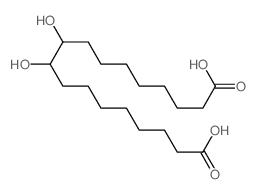Octadecanedioic Acid

Product Description
Octadecanedioic acid, also known as dioctadecanedioic acid or C18 dicarboxylic acid, is a long-chain dicarboxylic acid with various industrial and commercial applications.
Product:
Octadecanedioic Acid
CAS:
871-70-5
Synonym:
1,16-Hexadecanedicarboxylic acid; dioctadecanedioic acid; C18 dicarboxylic acid
Structure:

Typical Characteristics
Appearance
White crystalline powder
Density
1.0 g/cm3
Melting point
125 °C
Molecular Weight
314.46
Purity
≥98%
Refractive index
1.486
Uses, Applications & Markets
Key applications
get a quote
We Offer Octadecanedioic Acid
in various grades
A few of the grades available are listed below:



Octadecanedioic Acid used in many
industry applications
Octadecanedioic acid, also known as dioctadecanedioic acid or C18 dicarboxylic acid, is a long-chain dicarboxylic acid with various industrial and commercial applications. Here are some of its uses:
- Plasticizers: Octadecanedioic acid and its derivatives are used as plasticizers in the polymer industry to improve the flexibility, durability, and processability of thermoplastic and thermoset materials. They can be incorporated into polymeric formulations such as polyesters, polyurethanes, and polyamides to enhance their mechanical properties, reduce brittleness, and increase resistance to heat and chemicals.
- Lubricants: Octadecanedioic acid esters are used as lubricant additives and base oils in industrial lubricants, metalworking fluids, and hydraulic fluids. They provide lubricity, anti-wear protection, and corrosion inhibition properties to lubricating formulations, improving the performance and longevity of machinery and equipment in automotive, aerospace, and manufacturing applications.
- Personal Care Products: Octadecanedioic acid and its derivatives are used in the formulation of personal care products such as cosmetics, skincare products, and hair care products. They can serve as emollients, moisturizers, and conditioning agents to hydrate skin and hair, enhance texture and spreadability, and provide a soft, smooth feel. Octadecanedioic acid esters are often used in creams, lotions, serums, and hair conditioners.
- Corrosion Inhibitors: Octadecanedioic acid and its salts are used as corrosion inhibitors in metalworking fluids, rust preventives, and industrial coatings. They form protective films on metal surfaces, inhibiting corrosion and oxidation caused by exposure to moisture, air, and aggressive chemicals. Octadecanedioic acid derivatives are effective in preventing rust and corrosion in automotive components, machinery, pipelines, and marine equipment.
- Surface Coatings: Octadecanedioic acid can be polymerized or cross-linked to form durable coatings and films on surfaces such as metals, plastics, and textiles. These coatings provide protection against abrasion, UV degradation, and environmental damage, making them suitable for applications in automotive coatings, protective coatings, and architectural coatings.
- Adhesives and Sealants: Octadecanedioic acid derivatives are used as components in the formulation of adhesives, sealants, and caulks. They can improve adhesion, cohesion, and flexibility in adhesive formulations, enabling bonding of various substrates such as metals, plastics, wood, and composites. Octadecanedioic acid-based sealants offer weather resistance and durability in construction, automotive, and aerospace applications.
- Textile Treatments: Octadecanedioic acid derivatives are used in textile finishing treatments to impart water repellency, stain resistance, and wrinkle resistance to fabrics. They can be applied as coatings or finishes on textiles such as clothing, upholstery, and outdoor fabrics to enhance their performance and longevity. Octadecanedioic acid esters are also used in dyeing and printing processes to improve color fastness and dye uptake.
- Biomedical Applications: Octadecanedioic acid derivatives have potential applications in biomedicine and pharmaceuticals as excipients, drug delivery carriers, and biomaterials. They can be modified to exhibit biocompatibility, biodegradability, and controlled release properties for use in tissue engineering, drug encapsulation, and medical device coatings.
- Chemical Intermediates: Octadecanedioic acid serves as a precursor or intermediate in the synthesis of various specialty chemicals, surfactants, and functional materials. It can undergo esterification, amidation, or polymerization reactions to produce a wide range of derivatives with diverse properties and applications in industries such as coatings, plastics, and personal care.